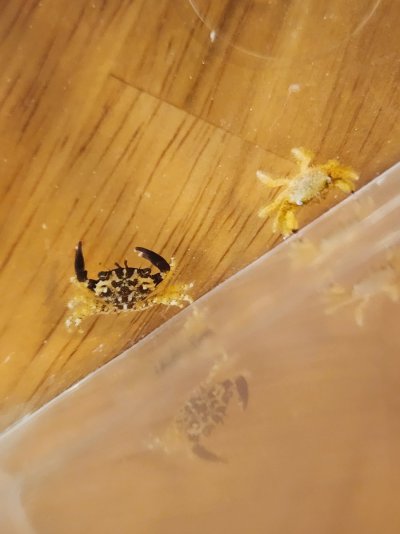Navigation
Install the app
How to install the app on iOS
Follow along with the video below to see how to install our site as a web app on your home screen.
Note: This feature may not be available in some browsers.
More options
You are using an out of date browser. It may not display this or other websites correctly.
You should upgrade or use an alternative browser.
You should upgrade or use an alternative browser.
Crab id
- Thread starter Boj4k
- Start date
- Tagged users None
that's a neat looking crab, maybe @ISpeakForTheSeas knows!
White one is a hairy coral crab, they usually can be found living inside acropora or any sps that branches, unsure if they are safe but i think they are neutral, they dont kill the coral they just take food and doesnt defend the coral compared to trapezia crabs.
White one is not a hairy coral crab, it is a gorilla crab and absolutely not reef safe they eat corals, inverts and like any horribly opportunistic crab will eat fish when they get big enoughWhite one is a hairy coral crab, they usually can be found living inside acropora or any sps that branches, unsure if they are safe but i think they are neutral, they dont kill the coral they just take food and doesnt defend the coral compared to trapezia crabs.
Claws look like a mithrax crab, e.g., emerald crab. Shell carapace also. Can you get a closer look at the claws? Might be a keeper!
the black white one is probably related to Chlorodiella cytherea. they look like emerald crabs with their claws being flattened at the tips like emerald crabs and i think they are reef safe. heres what they look like but they can also be full black.
@ISpeakForTheSeas @EeyoreIsMySpiritAnimal here's an interesting one.
that's a neat looking crab, maybe @ISpeakForTheSeas knows!
Sorry, life got super busy for me recently.@ISpeakForTheSeas @EeyoreIsMySpiritAnimal here's an interesting one.
For the crabs:
I actually think you may want to consider if these might be the Furry Coral Crab, Cymo melanodactylus - the bluish eyes with the on these are pretty distinctive, and the black claws are typical of this species.I found 5 very clear gorilla crabs on other colonies
Yeah, I have to agree that this one is likely a juvenile Chlorodiella species (the patterning, color, and texture of the shell and legs may change as it ages) - I'm not sure of the exact species, but C. cytherea isn't a bad guess.this guy is pretty darn different (unidentified on the left,
That said, these aren't usually kept, but I know some people have kept C. nigra.
Using C. nigra as a baseline for the genus, these crabs should be safe until they're nearly full grown:
I'm fairly confident you've got a young Chlorodielline crab of some variety there, probably a Chlorodiella sp., possibly C. nigra, but I'm not entirely sure.
The pattern on the legs may change a bit as it ages, and it should develop a somewhat rougher carapace, but it should stay small (adults of most of these species have a carapace size typically right around ~0.4"-0.75" full grown, so it really shouldn't pose a threat to most livestock - no guarantees with corals though) - there are claims that these can reach 8 cm/~3.14" full grown; I have seen absolutely no evidence to support that (even if you include the legs in the measurements).
I have seen one exceptionally large individual with a carapace width slightly less than 3 cm (it was ~1" carapace, and ~6 cm total counting fully outstretched legs); even at that size, it should be around the same size to somewhat smaller than a grown emerald crab.
I have also seen these for sale as "Black Mithrax Crabs" (no, they are not Mithrax crabs, nor are they closely related) - they're purportedly reef-safe, but I've also heard they may eat small inverts (like brittle stars).
They're safer than most crabs, but I'd say probably reef-safe with caution (not many people keep them, though, so that's from a small sample size to work with).
They're technically Xanthid crabs (which are generally not reef-safe), but these are generally very small, and at least one related species (Chlorodiella nigra) is sold occasionally as a "Black Mithrax Crab." I know at least one was kept without causing problems until it was full grown (then it reportedly started eating small inverts), but even emerald crabs are known to sometimes cause issues when larger.
Similar threads
- Replies
- 7
- Views
- 210
- Replies
- 10
- Views
- 449
- Replies
- 5
- Views
- 153


















